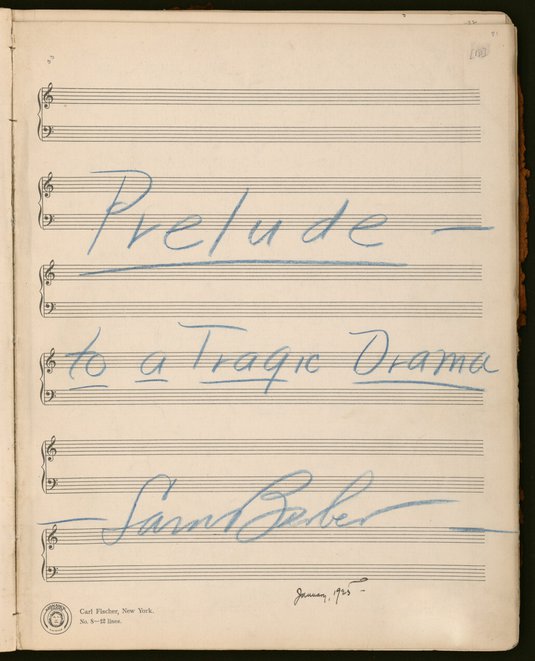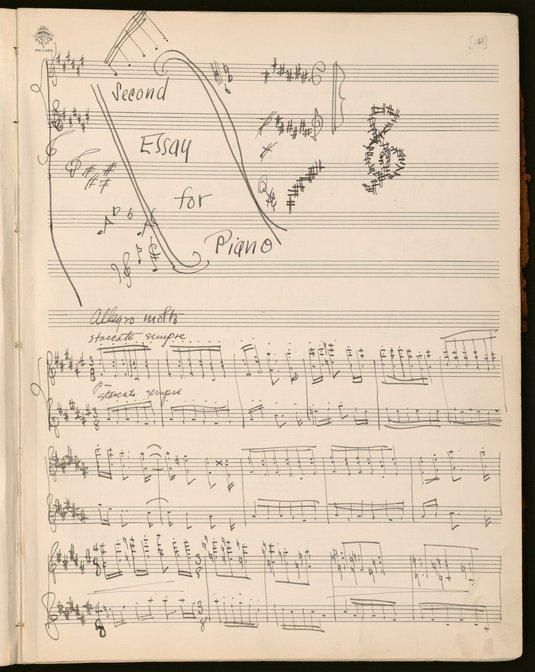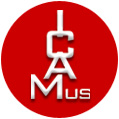Samuel Barber Complete Thematic Catalogue - Sibelius SCORCH files for Chapter 2. Adolescence.
Barber's score incipits for all his early pieces. Samuel Barber: A Thematic Catalogue of the Complete Works by Barbara B. Heyman, published by Oxford University Press; in the volume, all excerpts from the published and unpublished works of Samuel Barber are reprinted by permission of G. Schirmer, Inc., and the Samuel Barber Trust. Sibelius SCORCH files for Chapter 2: Works 1924-1929 (H-20 to H-58). This section includes the compositions Samuel Barber wrote as a teenager.
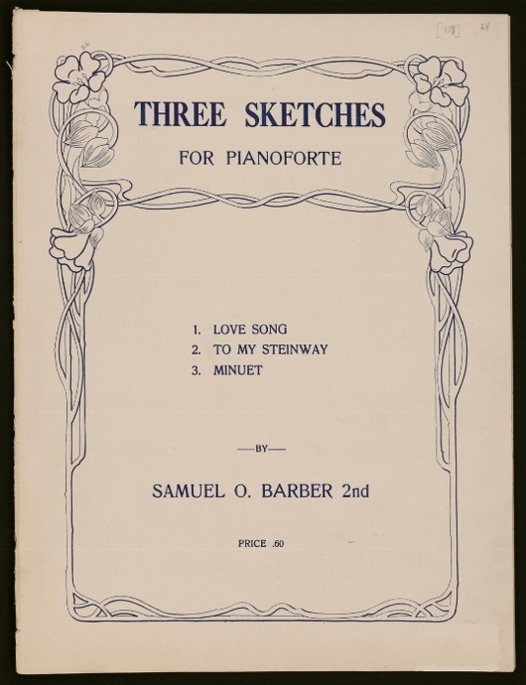
View and listen to the score incipits and relevant Sibelius SCORCH audio files of Samuel Barber’s Thematic Catalogue. The Table of Contents and the Index Numbers refer to Samuel Barber: A Thematic Catalogue of the Complete Works by Barbara B. Heyman (Oxford University Press, 2012). This online publication is an innovative ICAMus project carried out by special arrangement with Dr. Heyman and with the Publisher. Barbara Heyman is the author of Samuel Barber: The Composer and His Music (Oxford University Press, 1992).
* Note. If you are unable to view the Sibelius SCORCH files, please install the plug-in here. It is free and easy. The plug-in allows you to view and listen to the score incipits of Samuel Barber’s Thematic Catalogue, inclusive of all his early, rare, unpublished and incomplete compositions. The Sibelius score incipit for each work follows the title it refers to.
SAMUEL BARBER (1910-1981)
REGISTER OF INCIPITS
PART 2 (1924-1929) H-20 to H-58
H-20 Three Sketches For Pianoforte. 1923-1924.
a. Love Song
b. To My Steinway
c. Minuet
H-21 Fantasie for Two Pianos (Sonata in the Modern Form; Written in the Style of Josef Haydn). 1920-1924.
H-22 My Fairyland, Op. XIV. Text by Robert T. Kerlin (1866-1950). For high voice and piano; 1924.
H-23 Two Poems of The Wind. Text by Fiona Macleod (pseudonym for William Sharp; 1855-1905). For medium voice and piano; 1924.
a. Little Children of the Wind
b. Longing
H-24 October Mountain Weather. Text by Samuel Barber. For high voice and piano; 1924.
H-25 A Slumber Song of The Madonna. Text by Alfred Noyes (1880-1956). For medium voice and piano; 1925.
H-26 Dere Two Fella Joe. Text told to Barber by a White Mountain Guide. For voice (high or low) and piano; 1924.
H-27 Prelude to a Tragic Drama. For piano; 1925.
H-28 La Nuit. Text by Alfred Maurath (dates unknown). For high voice and piano; 1925.
H-29 To Longwood Gardens. For organ; 1925.
H-30 Fresh From West Chester (Some Jazzings). For piano; 1925-1926.
I. Poison Ivy
Second Theme
II. Let’s Sit It Out; I’d Rather Watch: A Walls
H-31 Main Street. For piano (and voice?); ca. 1925.
H-32 Music, When Soft Voices Die. Text by Percy Bysshe Shelley (1792-1822). For medium voice and piano; 1925.
H-33 Two Songs of Youth. For medium voice and piano; 1925.
a. Invocation to Youth. Text by Laurence Binyon (1869-1943).
b. I Never Thought That Youth Would Go. Text by Jessie B. Rittenhouse (1869-1948).
H-34 Fantasy in Purple. Text by Langston Hughes (1902-1967). For medium voice and piano; 1925.
H-35 Au Claire de la Lune: A Modern Setting of the old Folk-Tune. Traditional Text. For medium voice and piano; 1926.
H-36 Watchers. Text attributed to Dean Cornwell (1892-1960) / Edgar Daniel Kramer. For medium voice and piano; 1926.
H-37 Alma Mater. Text of West Chester High School graduation song. For voice and piano; 1926.
H-38 Man. Text by Humbert Wolfe (1886-1940). For high voice and piano; 1926.
H-39 Thy Love. Text from Elizabeth Barrett Browning (1806-1861). For medium voice and piano; 1926.
H-40 To Aunt Mamie on Her Birthday. For piano; 1926.
H-41 Three Essays. For piano; 1926.
a. No. I
b. No. II
c. No. III
H-42 Ask Me to Rest. Text by Edward Hicks Streeter Terry, a Pennsylvania poet, ca. 1910-1920. For high voice and piano; 1926.
H-43 Three Songs: The Words from Old England. Texts from Oxford Book of English Verse: 1250-1900, ed. Arthur Quiller-Couch (1919). For low voice and piano; 1925-1926.
a. Lady, When I Behold the Roses. Traditional English text.
b. An Earnest Suit to His Unkind Mistress Not to Forsake Him. Text by Sir Thomas Wyatt (1503?-1542).
c. Hey, Nonny No! Text of Christ Church Ms.
H-44 Mother, I Can Not Mind My Wheel. Text by Walter Savage Landor (1775-1864). For medium voice and piano; 1927.
H-45 Thirteen Rounds. For 3 and 4 voices (12 unaccompanied; 1 accompanied); 1927.
a. A Lament. Text by Percy Bysshe Shelley (1792-1822).
b. To Electra. Text by Robert Herrick (1591-1674).
c. Farewell. Text by unknown author.
d. Dirge. Traditional text.
e. Not I. Text by Robert Louis Stevenson (1850-1894).
f. Of a Rose Is Al Myn Song. Text by unknown author, 1350.
g. Sunset. Text by Robert Louis Stevenson (1850-1894).
h. The Moon. Text by Percy Bysshe Shelley (1792-1822).
i. Sun of the Sleepless. Text by Lord Byron (1788-1844).
j. The Throstle. Text by Alfred Lord Tennyson (1809-1892).
k. Late, Late, So Late. Text from Alfred Lord Tennyson (1809-1892).
l. When Day Is Gone. Text by Robert Burns (1759-1796).
m. The Moon (with pf). Text by Percy Bysshe Shelley (1792-1822); same text as h.
H-45arr Duett: Summer Is Coming. Text from Alfred Lord Tennyson (1809-1892). For 2 middle-range voices and piano; 1927.
H-46 Two Chorale Preludes. 1927.
a. “Ach Gott, von Himmel sieh’ darein”. For voice and keyboard.
b. “O Jesu Christ, du höchster Gut”. For organ.
H-47 Two sets of 4 Partite Diverse sopra “Herr, straf mich nicht in deinem Zorn”. For keyboard; 1926-1927.
a. I
a. II
a. III
a. IV
b. Chorale Vorspiel
b. I
b. II
b. III
b. IV. Canone alla quarta
H-48 Five Fugues for Two, Three, and Four Voices. For piano; 1927.
a. Fughetta per Pianoforte
b. Fughetta per Pianoforte
c. Fuga a tre voci
d. Fuga [4 voices]
e. Fugue [4 voices]
H-49 Four Canons. For keyboard; 1926-1927.
a. Canone alla quarta
b. Canone alla terza
c. Canone alla seconda
d. Canone all’unisono
H-50 Unlocated compositions
H-51a Dance. Text by James Stephens (1882-1950). For medium voice and piano; 1927.
H-51b-f Unlocated compositions
H-52 The Daisies, Op. 2, No. 1. Text by James Stephens (1882-1950). For middle voice and piano; 1927.
H-53 Prelude and Fugue for Organ. 1927.
a. Prelude
b. Fugue
H-54 There’s Nae Lark. Text by Algernon Charles Swinburne (1837-1909). For medium voice and piano; 1927.
H-55 With Rue My Heart Is Laden, Op 2, No. 2. Text by A.E. Housman (1859-1936). For high or low voice and piano; 1927.
H-56 The Shepherd to His Love and the Nymph’s Reply. For low voice and piano; 1928.
a. The Shepherd to His Love. Text by Christopher Marlowe (1564-1593).
b. The Nymph’s Reply. Text by Sir Walter Raleigh (1554-1618).
H-57 Sonata for Violin and Piano in F minor, Op. 3. 1927-1928.
a. I, Vln part only, an earlier version in E minor
b. III
H-58 Serenade for String Quartet (or String Orchestra), Op. 1. 1928-1929.
I. Un poco adagio. Allegro con spirito
II. Andante con moto; and III. Dance
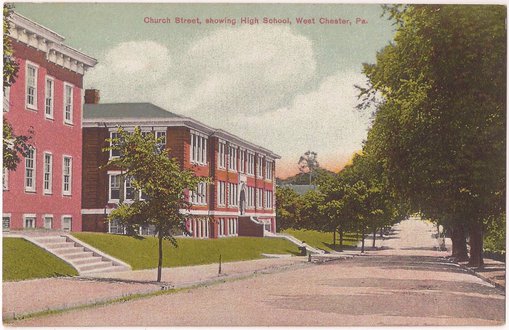
SAMUEL BARBER - THEMATIC CATALOGUE INDEX:
PART 1
Samuel Barber Complete Thematic Catalogue - Sibelius SCORCH files for Chapter 1. Childhood.
Earliest Works, 1917-1923 (H-1 to H-19). This section includes the first compositions Samuel Barber wrote as a child.
PART 2
Samuel Barber Complete Thematic Catalogue - Sibelius SCORCH files for Chapter 2. Adolescence.
Works 1924-1929 (H-20 to H-58). This section includes the compositions Samuel Barber wrote as a teenager.
PART 3
Earliest Works, 1930-1939 (H-59 to H-94). This section includes the pieces Samuel Barber wrote in his youth.
PART 4
Works 1940-1949 (H-95 to H-117). This section includes the pieces Samuel Barber wrote in his thirties, among which the Capricorn Concerto Op. 21, the Concerto for Violoncello and Orchestra Op. 22, and the Piano Sonata Op. 26.
PART 5
Works 1950-1959 (H-118 to H-129). This section includes the pieces Samuel Barber wrote in his more mature years, among which Hermit Songs Op. 29, and the opera Vanessa, to a libretto by Gian Carlo Menotti.
PART 6
Works 1960-1969 (H-130 to H-139). This section includes the pieces Samuel Barber wrote over a decade, among which the Piano Concerto Op. 38, and the opera Antony and Cleopatra, to a libretto adapted from Shakespeare by Franco Zeffirelli.
PART 7
Samuel Barber Complete Catalogue - Sibelius SCORCH files for Chapter 7. 1970-1981: The Last Years.
Works 1970-1981 (H-140 to H-146). This section includes the last pieces that Barber completed, among which the Ballade for piano and the Third Essay for Orchestra.
PART 8
Samuel Barber Complete Catalogue - Sibelius SCORCH files for Chapter 8. Unidentified Fragments.
Unidentified Manuscripts (H-U1 to H-U8). This section includes holograph sketches and fragments from different time periods of the composer's career.
Please note: All of our Barber website pages include a direct link to install the plug-in for viewing and playing the music incipits. Plug-in installation is free and very easy. Installation and fruition of Sibelius Scorch may feature differently on different operating systems and browsers, and various versions of them. For system requirements and full compatibility information, please read this.
